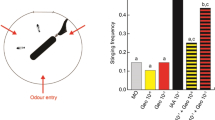Abstract
The application of smoke to honey bee(Apis mellifera) antennae reduced the subsequent electroantennograph response of the antennae to honey bee alarm pheromones, isopentyl acetate, and 2-heptanone. This effect was reversible, and the responsiveness of antennae gradually returned to that of controls within 10–20 min. A similar effect occurred with a floral odor, phenylacetaldehyde, suggesting that smoke interferes with olfaction generally, rather than specifically with honey bee alarm pheromones. A reduction in peripheral sensitivity appears to be one component of the mechanism by which smoke reduces nest defense behavior of honey bees.
Similar content being viewed by others
References
Allan, S. A., Slessor, K. N., Winston, M. L., and King, G. G. S. (1987). The influence of age and task specialization on the production and perception of honey bee pheromones.J. Insect. Physiol. 33 917–922.
Biamonte, G. (1974). Engorgement behavior of honey bees (Apis mellifera) stimulated by smoke.Am. Bee J. 114 97–99.
Bjostad, L. B., and Roelofs, W. L. (1980). An inexpensive electronic device for measuring electroantennogram responses to sex pheromone components with a voltmeter.Physiol. Entomol. 5 309–314.
Boch, R. Shearer, D. A., and Stone, B. C. (1962). Indentification of isoamyl acetate as an active component in the sting pheromone of the honey bee.Nature 195 1018–1020.
Cantelo, W. W., and Jacbson, M. (1979). Phenylacetaldehyde attracts moths to bladder flower and to blacklight traps.Environ. Entomol. 8 444–447.
Conrad, H. S. (1940). Bees raise questions.Sci. Mon. N.Y. 51 57–64.
Crane, E. (1985).The Archeology of Beekeeping, Cornell University Press, Ithaca, NY.
Fraser, H. M. (1951).Beekeeping in Antiquity, 2nd ed., University of London Press, London.
Free, J. B. (1968). Engorging of honey by worker honeybees when their colony is smoked.J. Apic. Res. 7 135–138.
Newton, D. C. (1968). Behavioural response of honeybees to colony disturbance by smoke. I. Engorging behavior.J. Apic Res. 7 3–9.
Newton, D. C. (1969). Behavioural response of honeybees to colony disturbance by smoke. II. Guards and foragers.J. Apic. Res. 8 79–82.
Robinson, G. E. (1987). Modulation of alarm pheromone perception in the honey bee: Evidence for division of labor based on hormonally regulated response thresholds.J. Comp. Phys. 160 613–619.
Shearer, D. A., and Boch, R. (1965). 2-heptanone in the mandibular gland secretion of the honeybee.Nature 206 530.
Thiery, D., Bluet, J. M., Pham-Delègue, M. H., Etiévant, P., and Masson, C. (1990). Sunflower aroma detection by the honeybee; study by coupling gas chromatography and electroantennography.J. Chem. Ecol. 16 701–711.
Author information
Authors and Affiliations
Rights and permissions
About this article
Cite this article
Visscher, P.K., Vetter, R.S. & Robinson, G.E. Alarm pheromone perception in honey bees is decreased by smoke (Hymenoptera: Apidae). J Insect Behav 8, 11–18 (1995). https://doi.org/10.1007/BF01990966
Accepted:
Issue Date:
DOI: https://doi.org/10.1007/BF01990966




